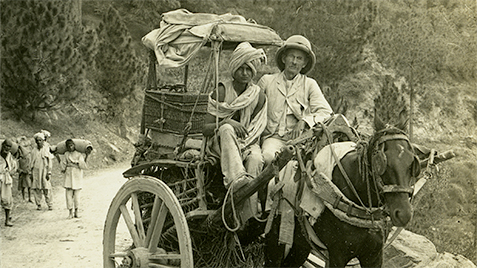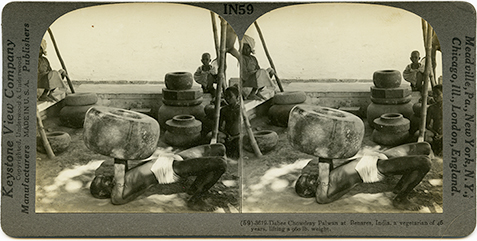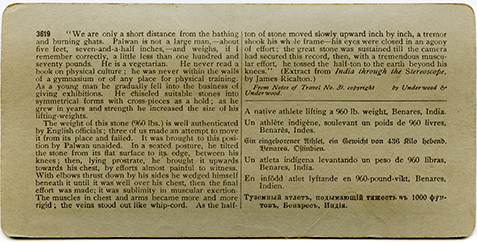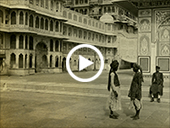

For Associate Professor of Religion Andy Rotman, a new collection of unique 3-D images depicting India in the 1890s is more than just a series of arresting pictures; these renderings of vintage stereographic photographs can help us understand how cultures are created.
/ Published April 15, 2013
Leave it to Andy Rotman, an associate professor of religion with a special interest in how images help inform our identities, to find ways to match 21st-century technology with 19th-century photography and bring century-old scenes of India into vivid focus for his students.
The photographic images are actually stereographs, an early form of photography that gives the perception of three-dimensional (3-D) depth. Two camera lenses only inches apart take photographs of the same subject at the same time; the two photos are then printed side-by-side to emulate natural human vision. When viewed through a stereoscope, a special device that blends the two nearly identical photos into a single picture, the resulting image appears in a surreal, hyper three dimensionality.

Rotman would like his students to use the stereographs, now digitized and online in the Andy Rotman Stereograph Collection, as starting points for further research and then link their papers (or other forms of scholarly output) to the images; that way, anyone in the world can see them, read the analysis and offer comments.
Creating the semblance of a three-dimensional world from two-dimensional photography is an idea that’s been around for more than 150 years. Starting in the mid 1800s, stereographic images were wildly popular among armchair travelers seeking to explore exotic locales they would never actually visit. Stereographs were not the only source of imagery being generated in the late 1800s, but they had a cutting-edge quality, which, at that moment in history, made them especially potent in shaping the collective imagination. They were also inexpensive, rendering these images available to a mass audience. Rotman compares stereographs’ impact to that of today’s hippest 3-D digital technology, which still visually takes audiences to worlds that they might never explore themselves—like Antarctica or the bottom of the sea.
The “really cool thing,” he says, is that we are approaching a fleeting “sweet spot” in which a technology from the 19th century and a technology from the 21st century are coalescing to elicit a “wow factor” from contemporary viewers. Both technologies have a way of capturing our attention not only with what the images portray, but also because of how the medium plays on our imaginations.
Eight years ago, Rotman’s uncle Steven, a collector of early Americana, happened upon 99 mint-condition stereographs depicting India in the 1890s. Knowing of his nephew’s research on South Asian visual culture, he purchased the lot and presented them as a gift. To Rotman, who is known for his scholarship on how the visual world helps shape religious identity, they were more than just a series of arresting pictures; they were emblematic of the mechanisms through which culture is created.

Andy Rotman
“Who we are isn’t just what we’ve read and what we’ve heard, but also what we’ve seen,” says Rotman. “That’s not a complicated idea, but how that’s put into practice is complicated.” In the case of the Indian subcontinent, part of what Rotman calls “the colonial project” involved generating images of people, landscapes, animals, architecture and rituals that helped justify colonial rule.
“This world of photography was not neutral,” says Rotman; it helped create a sense of “otherness” by highlighting aspects of life that were strange to the home audience. This in turn affected how both Europeans and the peoples of South Asia understood each other and, perhaps more importantly, themselves. “Often we understand who we are by figuring out who we are not,” says Rotman. “India became this place of castes and tribes, a world in opposition to the West—or, to some, in need of the West.”
But There Was a Problem
As a teacher, Rotman is constantly striving to find new ways to interest students in South Asian culture and history. But these stereographs, a powerful example of the exoticizing of India, never stirred his students. Was there a way to get students to feel some of the same excitement while looking at these images that people felt when they first saw them more than 100 years ago?
Enter Frank Citino, the multimedia developer in Smith’s office of Information Technology Services. It happens that the college had obtained a 3-D television shortly before Citino got a call from the Imaging Center’s Jon Cartledge. Cartledge, a digital imaging specialist in the art department, was adding two-dimensional renderings of Rotman’s unusual collection to the college’s online digital library, LUNA, and making it available as an open-access collection to the Five College community and the world. Citino surmised that since, with the help of special glasses, this television screen rendered content in a way the brain perceived as three dimensional, it should be possible to use this technology to view the stereographs with the same effect.
The next logical step was to search the Internet for guidance on how others accomplished this task. Not finding any precedents, Citino set about figuring out a technique for doing something that probably had never been done before. It involved using Photoshop to clean up the edges of the side-by-side images and choosing a reference point with which to align them. In one case it was the nose of a man standing among the aerial roots of what is described on the back of the stereograph card as “the largest and most celebrated banyan tree in India,” located at the botanical garden in Calcutta. Then came a good deal of trial and error to find the exact offset that the dual 19th-century images needed in order to achieve the 3-D effect with 21st-century technology. Once Citino established the parameters, he enlisted students to systematically render all 99 stereographs so that they could be seen on the screen in 3-D when viewed with the accompanying glasses.

These side-by-side photographic images are created when two camera lenses only inches apart take photographs of the same subject at the same time; the two photos are then printed side-by-side to emulate natural human vision. When viewed through a stereoscope, the resulting image appears in a surreal, hyper three dimensionality.

Creating the semblance of a three-dimensional world from two-dimensional photography is an idea that’s been around for more than 150 years. Starting in the mid 1800s, stereographic images were wildly popular among armchair travelers seeking to explore exotic locales they would never actually visit.
Citino had his own motivations for this undertaking. “Our focus is to not just look at the educational technology that’s available but to also look ahead,” he says. “If you look at Hollywood trends, everything is coming out in 3-D these days, so we really needed an excuse to investigate it, and this project was a great one.”
Problem Solved
Rotman is struck by how people react to seeing his stereographs in 3-D on a large-screen TV. They experience a sense of awe akin to the effect these images had when viewed more than a century ago through a stereoscope that brought the merged images into combined focus. A few years from now, when 3-D screens are more ubiquitous, the sense of wonder will be gone again. Next-generation smartphones are already promising screens with 3-D properties that won’t need special glasses. Soon, seeing a 3-D image on a screen will be commonplace and unremarkable.
“The emergence of 3-D visualization is part of a broader trend to create immersive learning experiences for students. For example, Duke University recently created a 3-D exploration station to study how three-dimensional visualization might help enhance learning in higher education,” says Elisa Lanzi, incoming director of digital strategies and services for the College Libraries.
“If there was ever a moment to revive the stereograph, it is right now when this 3-D technology is new and exciting...but it too will pass, and then there will be something else. That’s the nature of technology,” says Rotman. For now, he is relishing the opportunity to help others experience the power and wonder of these images, and place them in historical context.
“One of the pleasures of being able to re-create the 3-D viewing experience is that students get some sense of the feel that these stereographs first generated. I can explain that viewers found them ‘surreal,’ ‘awesome,’ ‘wondrous,’ but actually stimulating some of those emotions in my students allows for a completely different learning experience. The technology is perfect for that right now.”


















